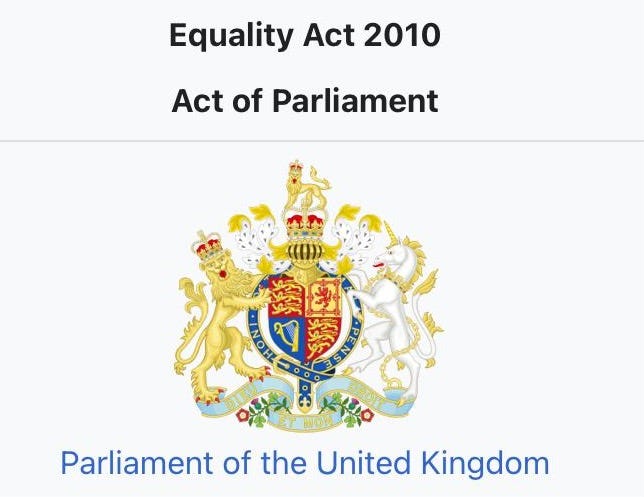Challenging flawed NHS Equality Impact Assessments (EQIAs)
EQIAs are intended to ensure fairness across all groups protected under the Equality Act (2010)
This blog explains how you can use the EQIA to take direct, effective steps against flawed or unlawful policies in the NHS. There is a broader conversation about challenging policies where sex and gender have been conflated, in light of the Supreme Court judgement, which will be covered in a future blog.
Every NHS policy is accompanied by an Equality Impact Assessment (EQIA), intended to ensure fairness across all groups protected under the Equality Act (2010). The EQIA can be used to challenge the policy-makers and ensure they are re-written to be lawful documents by setting out the impact of each policy on each protected group.
Step 1: Understand your legal foundation
Thanks to Maya Forstater’s work and the resulting legal ruling (Forstater v CGD Europe and others), philosophical beliefs are protected under the Equality Act, just like religious beliefs. The belief in the importance of biological sex, is ‘worthy of protection' in law. When challenging a policy, clearly state that philosophical beliefs must be treated equally to religious beliefs.
Step 2: Challenge the HR and legal departments
Many HR and legal teams are unaware or misinformed about the Forstater ruling. They may have insufficient knowledge or have chosen to ignore it. When you first raise your concerns:
• Point out that any EQIA which only references Religion is incomplete and unlawful.
• Insist that the EQIA must properly consider philosophical beliefs.
Don’t be discouraged by a lack of knowledge — their ignorance is not your problem.
Step 3: Insist on equality between beliefs
There is ‘no hierarchy of beliefs’ under the Equality Act. No one belief system can be given automatic priority over another. Remind HR and leadership that:
• It is the employer’s responsibility to ensure fairness to all beliefs.
• You are not asking for special treatment — you are demanding lawful, equal treatment.
Step 4: Push back against ‘values’ overreach
Some NHS Trusts claim to go above the requirements of the Equality Act'. While good intentions are welcome, it has allowed conflict to arise and for Trust policies to be outside the law, as determined by the Supreme Court judgement of April 2025 (FWS v The Scottish Ministers).
If you are challenged with statements like “this doesn’t fit our values,” push back firmly:
• Ask if their values permit unlawful discrimination.
• Remind them that bullying policies cannot be used to silence lawful, protected beliefs.
Step 5: Make it formal
If you can demonstrate that an EQIA is inadequate, then the policy must be withdrawn and rewritten with a new comprehensive EQIA.
Take the following actions:
• Request the EQIA documents.
• Identify where protected characteristics — particularly philosophical belief and sex — have been ignored.
• Submit your concerns in writing
• Demand a formal review and withdrawal of the policy until a lawful EQIA is completed.
Final thoughts: Be knowledgeable and be persistent
• Do not give up. Every successful challenge strengthens lawful practice across the NHS.
• Use the law to your advantage. You are not asking for favours, you are demanding fairness and lawfulness.
• Remember: A flawed EQIA equals a flawed policy.
It worked in one Trust, and it can work for you.





Thank you so much for this very timely post. So many public sector policies just don’t have an EqIA at all. Or it’s so poorly written.
Any advice please (or maybe a follow up post) on what data and consultations a good example would use? And typical details to challenge. For example:
Numerous policies don’t list the 9 protected characteristics properly. Gender is often inserted in place of sex. Or sex is just missed out entirely. There were other basic mistakes. Is there a guide on how to write a good EqIA anywhere that we can use as a checklist?
I saw one NHS Trust that had used data from their own area only. The sample size was obviously too small. Any suggestions for female based data with large enough samples? YouGov polling on attitudes to different sex/gender reassignment issues?
If public bodies are conflating sex and gender in the data they gather - how do we challenge their figures? For example the Society of Radiographers want to allow males into the profession. Up to now it should have been female only. How does anyone find out how many males are working lawfully in mammography prior to 16th May 2025 if those males have inaccurate sex data on their employment records?
Etc etc. I’d love to hear your thoughts. Thanks for such a great post